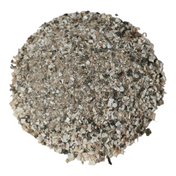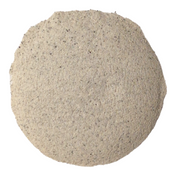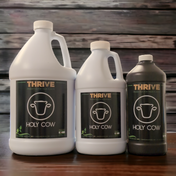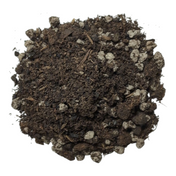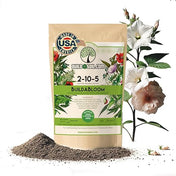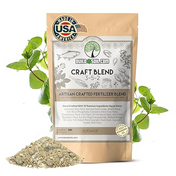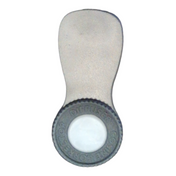Why Rock Dust? from BuildASoil on Vimeo.
https://www.youtube.com/watch?v=6qi2O9uDZrY
Information to help make an educated decision on the use of rock dust in your potting soil or garden. Here at BuildASoil we grow in a No-Till style Potting soil system and many of the growers that follow this process use rock dust in their recipes and swear by it. In this video you'll find most of the information and sources used to formulate a decision on wether or not to use rock dust.
Free Resources On Rock Dust:
1. Bread From Stones https://cdn.shopify.com/s/files/1/024...
3. Lifes Rocky Start Science Documentary - https://www.youtube.com/watch?v=WL96T...
4. Rock Dust Primer – Thom Vanacore https://cdn.shopify.com/s/files/1/024...
5. Paramagnetism - Rediscovering Nature's Secret Force of Growth by Philip S Callahan Ph.D Book
6. Paramagnetism - A write up by Philip Callahan from Acres USA https://cdn.shopify.com/s/files/1/024...
7. Rock Dust Local!! https://rockdustlocal.com/index.html
8. https://buildasoil.com/collections/minerals
FULL VIDEO TRANSCRIPT:
BuildASoil Video Transcript for “Why Rock Dust”
Hey, this is Jeremy with BuildASoil and this episode is about rock dust and specifically why we wanna use rock dust. I've got some notes here just so I don't forget all of the different topics, but the purpose of this video is to walk you through the process of researching rock dust from the perspective of a brand new gardener. And what I mean by that is if you get into organic farming, organic gardening, somebody's gonna mention rock dust to you and it might be as part of a compost tea, it might be under a brand name, like Azomite or it might be because somebody sent you to a website like remineralize.org and I'm gonna share with you a number of different resources so you can do your own research and I'm gonna bring up the topics that would be controversial or that would be interesting to someone that is wanting to further understand rock dust.
And in that way I hope to allow you to become dependent, I'm sorry, independent with your own research as opposed to dependent on my answer. And then when someone asks you why you use rock dust, you can formulate your own opinion, because some of this, even though we have some science, is gonna be left up to your own gut feeling and your intuition and oftentimes when we formulated a decision in our mind, we wanna make sure that we've done the research and then in the future when we question that, it saves time to not have to constantly revisit every single one of these reasons. And I also wanna make sure that just because we've decided on something here at BuildASoil that doesn't mean that you shouldn't do the research on your own so you can arrive at the same conclusion we did for maybe a different one and then I think you'll value our process a lot more.
So, why rock dust? Well, the basic reasons, I've got six reasons here. The first one is most basic, minerals. That's why we use ground up rocks. The second one is for the texture. If we're making a potting soil, obviously it's gonna be mostly organic matter and if we wanna mimic nature, then we want to get some minerals in there, because that's what soil is. It's ground up minerals, chunks of minerals and organic matter and sand and other things and so basically mineral organic matter, we're trying to build soil and without it it's hard to say that we have anything more than just a soilless, like a hydroponic medium as opposed to a potting soil, which is what we're trying to make. So, that's minerals and texture. The third one would be biomimicry, and I hinted on that, but a lot of what we do here is if we don't understand all the nuances, a lot of the no-till community tries to mimic nature so that we can trust in natures answers as far as the results that nature gets.
Now, obviously we wanna do a little bit more. We wanna be good stewards of our plants. We are oftentimes monocropping indoors. And so I think that sometimes we can get a little bit too full of ourselves in the organic community and I wanna make sure that we use science and sound logical reasoning to make our decisions in our garden. So, that is minerals, texture, biomimicry. The fourth one would be the trace minerals, which are very important and why a lot of people use rock dust. And then the fifth one would be paramagnetism. I've got a book on that and I'll share this information with you at the end. And then a sixth one would be a soil test. So, if you've got a soil test that shows you're lacking in iron or silica or maybe some of the trace minerals, our rock dust might be a good source for you.
And so those are the main reasons why people look at rock dust. And so that's what we'll start the process. From there, I would like to play devil's advocate a little bit. Why not rock dust? There's a number of arguments out there that say that rock dust are insoluble nutrients that won't be available to the plant. And that most of the soil test won't show a specific need for a rock dust, but rather something more affordable that you could get specifically like a calcium rock or a phosphorus rock as opposed to Azomite or glacial rock dust or something of that nature. And so what I wanna do is talk about the differences so that you can make a decision for yourself whether you should or you shouldn't use rock dust and how it might benefit you. So, the types of rock dust that are on the market, they're specific types of mines for rock dust that are very important, because they're narrow in scope.
And so if you have a specific need for maybe calcium or sulfur, you could get gypsum. That's calcium sulfate. There's wollastonite, which is calcium silicate, and then there's green sand, which a lot of times people think of for potassium. What we're talking about today when we mention rock dust are not the specific ones like the lines which we'll get into later, but more a broad spectrum. So, we have a basalt that is from the Grand Mesa here and as far as biomimicry goes, the Grand Mesa is a jungle. It's beautiful. It's full of life. It has a lot of activities, 'cause there's like 300 lakes or something. Research the Grand Mesa here in Colorado. I think you'll be blown away if you haven't heard of it, but it's encapsulated in a lava flow. And what's nice about a basalt is it's a single source. We know what we're getting and it has paramagnetic energy and those are some of the things that I talked about previously.
So, that's what we use here. I'll show you the texture. It's got a variety of gradient and that's number two on my list of why rock dust is for the texture. And so you might have a great texture of soil and you're only specifically looking for the trace minerals, in which case you might wanna buy a rock flour and you can go to Rock Dust Local, Tom Vanacore or you can get something from Tom at the BuildASoil website. We have his basalt that I really like, that's a little finer where this is a gradient more for building soil. And then the other types of rock dust, the most popular you've probably heard of Azomite. If you hadn't, it's a made up name and it supposedly has all the minerals from A to Z and that's why it's called Azomite.
And, the glacial rock dust was the most recommended for a long time and a lot of that came from remineralize.org and one of the kind of godfather, so to speak of remineralizing is Hamaker. I'm not sure if I'm saying his name right, but the new primer on rock dust over at remineralize.org that's based on those teachings mentions basalt and I was talking to Tom about this years ago and it looks like he got that updated and I'll share that with you today. So, let's get back to topic. Types of rock dust. I mentioned there are specific dusts. We're not talking about those. Those are like limes, silicates, things like that or phosphorus. What we're talking about is broad spectrum rock dust and they're usually alumina silicates, like iron, aluminum and silica, and then locked in that matrix are all the trace minerals.
And as far as finding quality rock dust, I'll give you more information on that later. Some proponents that you should find the closest source to you and a lot of times that's gonna be a glacial rock dust or a local quarry of a specific broad spectrum mineral type rock dust. And then some people say that instead of using just a local quarry, you should get something that's already been tested and proven so you know you're getting a good product and there's lots of schools of thought there and I'll get into that paper next, but I just wanted to go over the popular types. So, Azomite, glacial rock dust and basalt and we choose basalt. We think it's the best. I'll get into that now. So, in the rock dust primer back to basics, which will be at the, in the footnotes here, you can get this over at remineralize.org by putting your email address in there.
Tom Vanacore from Rock Dust Local, very smart person. He talks about some of the differences. And so on here, it talks about John Hamaker promoted the use of glacial and alluvial rock dust sediments for remineralization. This choice is based on his objective of emulating glacial forces in revitalizing the planet through remineralization. So, if you think of the glaciers dragging minerals and causing this grinding and weathering of the rocks, weathering is how we ... The rock dust becomes available and so part of buying a rock that is unweathered and then crushing it and then putting in soil is so that we can harness the material that will now be weathered in our own container and I'll get more into the biology side of that in weathering, but let's go on on this. So, he recommended the glacial and alluvial rock dust, mainly glacial rock dust.
Okay. So, however volcanic geologic types such as the basalts and complex metamorphic and sedimentary hard rocks and clay's had been found to serve as well as the best regional glacial and alluvial sands and gravels. Quality of all rock dust materials should be quantified by purity, geochemical analysis, mineralogy and particle size. Glacial sediments often contain a higher percentage of hard minerals such as quartzite. So, the glacial often has a higher percentage of hard minerals. As the glacial and alluvial sediments are transported from there original location, over eons many of the softer minerals weather away. That's what I talked about with weathering, leaving a greater proportion of the harder, less nutritive minerals intact. Now, the unweathered magmas, such as basalt and other hard rock sediments derived from regional volcanism, ancient oceans, lagoons, or inland bogs often retain the rich mineral diversity and nutritive properties. So, seen in this light, both the single broad elemental spectrum hard rock or clay geology as well as the higher value glacial alluvial sediments can serve of Hamaker's objective of emulating natural forces to regenerate and revitalize the earth through remineralization.
So, that's what we're talking about when we discuss rock dust. And if you didn't catch that argument in there, basically what was happening is in the past, glacial rock dust was recommended. Going forward, basalt or these volcanic rocks, single broad elemental spectrum are gonna be a better bang for the buck, because we know better what we're getting and it's a single source instead of multiple sources as drug by a glacier. So much more information on here. Really a great report. I'll try and include it here or at least the location of where you can download this. And we carry some of his products on our website, which is why I really like talking about Tom. If you get into researching rock dust, you're going to find Tom Vanacore at Rock Dust Local. All right. So, next section, how to use it, how much and all that.
So, now we know why. We know it's for minerals, trace minerals. We know there's different types of rock dust that are out there. As far as how to use it, there's a couple of questions. How to apply it would be one, but then what you're gonna find is that if you research rock dust, some people say that it doesn't work and a lot of it is based on the quality of rock dust, the weathering and biology. And so if we're gonna be mimicking a really active soil, like we do at BuildASoil when we make our potting soil, we are including a lot of the things that nature would, because most of what ... When people get really into gardening, they talk about energy and it seems to be a common thing, that paramagnetic energy. Biodynamic speaking about the energy there and then another really good book that is a lot more scientific about agriculture and the energy.
They all talk about how the plant is kind of receiving the energy from the sun and it's grounded in the earth and it's almost like building a radio. And so when I think of my lack of understanding about how complex this subject is, I think that adding a little rock dust to our potting soil is helping with the biomimicry side, because I don't wanna miss out on a part of what may be creating that, closing the loop and creating that energy cycle. Of course you can grow plants without rock dust. So, it's gonna be very easy for people to say, look, you don't need this stuff. It's not available to the plants. And so when you research those tests, a lot of times it's more like in vitro or without the biology in there or in a soilless potting medium and small containers.
I think to see the benefit of rock dust, you have to do like the no till community does and that is adding Mycorrhiza, which is a special fungus that can help break down the rocks and deliver those nutrients to the plant and we also use worms that are gonna cause [inaudible 00:12:32] and all this rich diversity of bacteria and fungus that's gonna help break down the material and we know that the enzymes that are created in that process are very specific to what they're breaking down. So, what you see in a lab on paper is different than what you see with a lot of biology and nature. And so to the best of our ability at BuildASoil, we wanna honor science and make sure that we take that into our decision making process, but when trying to mimic nature, we also wanna make sure we include the processes that we may not completely understand yet.
And that's where rock dust comes in. And so on the how much side, what we've noticed from soil testing is that if we were to use Azomite in a high amount we would see too much available aluminum and that's why we don't recommend it. Small amounts, diversity totally fine. We have a basalt product that we often recommend at anywhere from say 10 to 50 pounds for a cubic yard of soil. And a lot of times that works out from a quarter cup all the way up to one or two cups per cubic foot of soil. Some people have recommended significantly more rock dust and what we have seen when we test a potting soil with large, large amounts of rock dust in it at the lab is that we see literally ... Usually a little bit of an imbalance in the iron and a few other things when they totally dissolve it out.
I don't think that really matters. I think you can use as much rock dust as you want, but in an effort to balance out the lab and create something that is a good chemical foundation for the biology then to work on, I would prefer to just use known amounts of rock dust that most people are using in the garden. And that's anywhere from a quarter up to maybe two cups per cubic foot. At home, you can mix a little more into your potting soil and do some experiments for yourself. I've not seen an increased benefit from adding more, however, if you run this soil back to back to back to back to back, the biology may unlock more of it and may be more important to either add more as you go or it may not matter at all. And so this is stuff you're gonna have to come up with on your own.
So, Mycorrhizae, worms, compost teas, all of these things will help weather that rock dust and break it down and make it available for your plants. And the other cofactor there, the other thing to think about is coenzymes, cofactors, things that are potentially part of this reaction that occurs that may not be apart of the end result, if that makes sense. So, things to research. Next thing would be fines versus chunks. If you look at the BuildASoil basalt, I'll try and hold that up to the camera. You can see there's fines and chunks in there. And so this really fine powder that you get in here is gonna be a lot more available than these big chunks. And so we try not to have anything that's more than a quarter inch in size and this helps us create a really nice potting soil texture with some for now, some for later.
And that's part of, again, that biomimicry process. You can also buy just a flower and use that. Some people really believe in that. I like to do like nature and get a gradient of all the different textures in there. Top dress versus tea, a lot of people add a little bit of rock dust into their teas and they feel like it helps their compost tea. I personally don't think that it does, unless you've worked the minerals into the compost while it's being made, 'cause most compost doesn't have nearly enough minerals in it. So, that's something to consider. I don't see any harm in it though. So, if a product you happen to be working with has minerals in it, like our craft blend has basalt and Azomite and a few other things, not a big deal. Go ahead and you can use small amounts.
Some people do use micronized minerals. And they get them in suspension and they foliar spray him. I've not really got into that. And so I can't really say that it's a plus or a minus. I try not to have to foliar spray the minerals. I feel like just from a natural perspective, plants should be able to pick that up through the soil. Let's see. Where to buy? So, now you've decided, hey, I like rock dust. It's got minerals and I make sure I use a lot of soil biologically active so I might be able to tap into those benefits, either in the short term or certainly in the longterm. Nature has done this forever with volcanoes and glaciers and so it makes sense that food grows really well in those areas and I wanna harness the same thing. I can put, say a half cup or a cup per cubic foot.
I can follow that 10 to 50 pounds of rock dust per cubic yard. You can also email us here at BuildASoil and we can walk you through some of those processes if you're making your own soil, but now where do I buy it? So, BuildASoil.com. We can ship you rock dust. We have our basalt. We work with Rock Dust Local and we have flat rate packages that really makes the shipping affordable and that's built into the cost. Another resource would be to go to the local garden store and then beyond that, if you go to remineralize.org sometimes there's information on there on local quarries that you might be able to find. You can always reach out to Rock Dust Local and talk to Tom Vanacore or go through their offerings that have been fully vetted, crushed, and he's got analysis on them way better than I could do.
He's unbelievable resource. Or what you can do is also go to ... For instance, over here they grind gravel and I've used that. I've sent it to the lab. It's a decent material. It's a glacial rock dust. And so you could go to a local mine and find out where they're crushing gravel and ask them about where they're getting this, what type of material it is, and I bet you could get it for free for your garden. And so that's another consideration. Again, do you really need it? If you live in Hawaii, you might not wanna buy volcanic rock dust. I mean your backyard is probably full of it. If you're making a potting soil from scratch and you wanna mimic nature, it might be advantageous for you to buy some. If you've got a raised garden bed and your soil is naturally sandy and devoid of minerals and you're trying to build a potting soil bed on top of that, adding rock dust would probably be really great.
You know, some of the people that live on the Grand Mesa out here, they're already have this basalt in their backyards, so there's not a reason for them to do that. So, I will say rock dust is great, but you don't always need it. We use it in our potting soil because we believe that it has paramagnetic energy, we believe that it creates a really good texture, is cost effective, and when we have the worms and the Mycorrhizae in there, it's very, very likely that we're actually accessing those nutrients and those trace minerals and it's making a difference in the plant growth. So, if you've got more questions, you can email them to support@BuildASoil.com. You can check out our Facebook or our Instagram and I'm gonna put this video up on Vimeo, hopefully on YouTube.
And then I should be linking maybe a snippet on Instagram so you guys can catch it out. If you've got questions like I mentioned email us or better yet post them on the video and I'll try and answer them. Again, this is not a detailed post on everything rock dust. I just want it to be a directional sign. So, if you look below, there's gonna be research on this book and where you can find more information about what paramagnetism is, what a magnetic field is, diamagnetism, ferromagnetism, all that stuff if it's intriguing to you. I also will put up the Rock Dust Local link, the rock dust primer by Tom Vanacore from remineralize.org and I'm gonna have a free ebook called Bread from Stones, which is one of the originals that kicked off a lot of this conversation for many people. So, I hope that you enjoyed this and have a great day.


